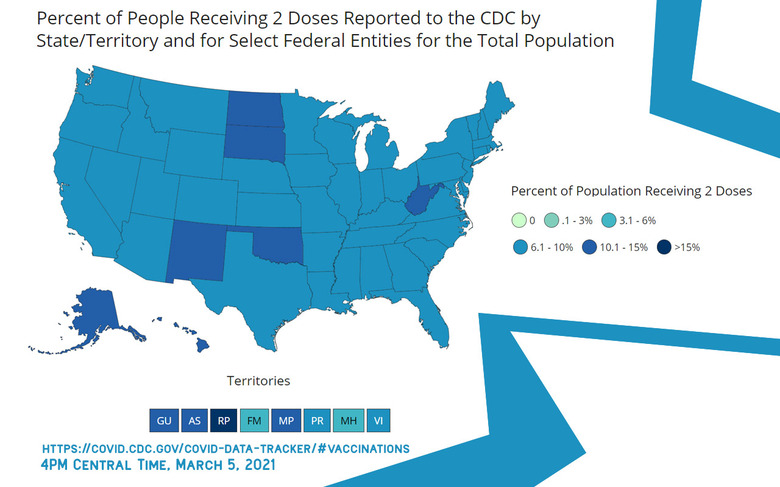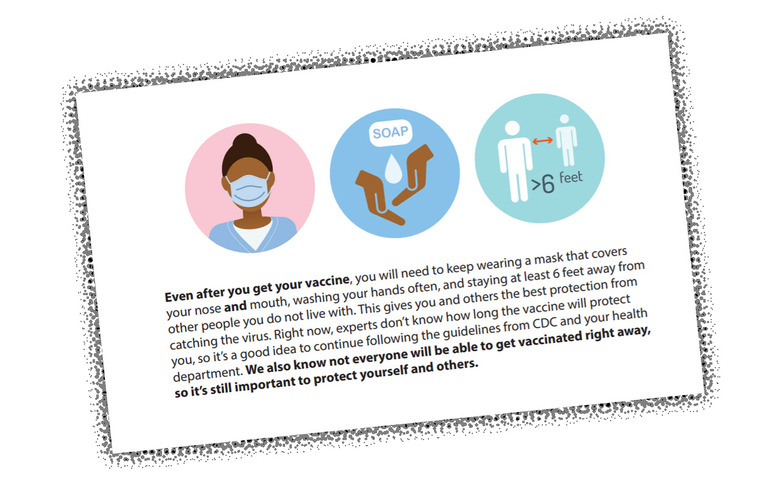CDC COVID-19 Vaccinated Guidance: Complex Situation, Simple Action
At a White House press briefing today, CDC director Rochelle Walensky confirmed that there would be new guidance for COVID-19 vaccinated individuals "soon." Per Walensky, "these are complex issues, and the science is rapidly evolving." In other words – vaccination is not a go-anywhere, do-anything pass for the person that's been vaccinated – it's not that simple.
Vaccine distribution numbers
Per the latest update to the CDC data tracker for COVID-19 vaccinations in the USA, approximately 109.9 million vaccine doses have been delivered, and 82.57 million vaccine doses have been administered. Of the total population of the United States, approximately 16.3% have had one or more doses of a vaccine, and just 8.4% have had 2 doses (the full set).
If we're looking at the population of the United States with only people over the age of 18, approximately 10.9% have had 2 doses of vaccine, 21.2% have had 1 or more doses of vaccine. It's interesting to see the CDC report this metric for the following reasons:
1. The vaccine is only available for people over the age of 18.
2. It is not only people over the age of 18 that can contract and/or spread COVID-19.

The CDC tracks reported data on vaccine distribution throughout the United States and provides a basic chart with by-state statistics. If we set the chart to show People receiving 2 doses as a percentage of the population (with total population, not just those people over the age of 18), we see ONE territory with a 2-dose percentage above 15% (the Republic of Palau).
Inside the basic 50 state map, the majority of states are in the range between 6.1-10%. That means that just under 1 out of every 10 people has been recorded as having received both doses of a COVID-19 vaccine. West Virginia, Alaska, Oklahoma, New Mexico, and both North and South Dakota are in the 10.1-15% range for population of those over 18 years of age that've received 2 doses of vaccine.
We're not suddenly safe
At the White House press briefing today, CDC director Rochelle Walensky said "what is more important is that people who have been vaccinated and those not yet vaccinated are able to understand the steps they can take to protect themselves and their loved ones."
SEE TOO: My COVID-19 vaccine experience was low-tech, and that's a good thing
The CDC has a COVID-19 vaccine recipient education guide which goes through some considerations people might make before and during a vaccination. It also shows some tips on how a person may feel after each dose of a vaccination, including but not limited to effects of the vaccine that may be mistaken for COVID-19 symptoms.
The CDC DOES provide a brief guide for recipients of either one of two vaccines for COVID-19 that closely replicates guidance for individuals before said vaccine. In other words: You should still take the SAME precautions you were taking before. From the official "Vaccine Recipient Fact Sheet" at the CDC site linked above and shown (in part) below:
"Even after you get your vaccine, you will need to keep wearing a mask that covers your nose and mouth, washing your hands often, and staying at least 6 feet away from other people you do not live with."

So while future post-vaccine guidance may be complex, the most basic and direct instructions from the CDC right now are simple. Keep being cautious – this is NOT over yet. People can still spread COVID-19, people can still get COVID-19, people can still get very, very sick and die.
